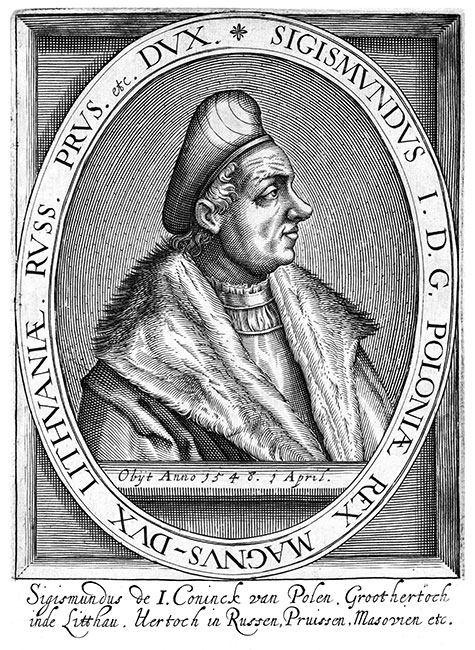Sigismund I, King of Poland
|
 Sigismund I, King of Poland and Grand Duke of Lithuania Engraving by Nicolas de Clerck |
Sigismund I, King of Poland, Grand Duke of Lithuania, King of Russia, Prussia, Mazovia, etc. What Wikipedia says about it : Sigismund I the Old (Polish: Zygmunt I Stary, Lithuanian: Žygimantas I Senasis; 1 January 1467 – 1 April 1548) was King of Poland and Grand Duke of Lithuania from 1506 until his death in 1548. Sigismund I was a member of the Jagiellonian dynasty, the son of Casimir IV and younger brother of Kings John I Albert and Alexander I Jagiellon. He was nicknamed "the Old" in later historiography to distinguish him from his son and successor, Sigismund II Augustus. Before ascending to the Polish and Lithuanian thrones, he was Duke of Głogów from 1499, Duke of Opava from 1501, and governor of Silesia from 1504 on behalf of his brother, King Vladislaus II of Bohemia and Hungary. Continued on Wikipedia Engraving from a collection of 88 engravings |
Text below taken from Louis Moreri's Grand Dictionnaire Historique - 1725 SIGISMUND I, King of Poland, whose noble deeds earned him the title of the Great, was the son of Casimir IV and brother of John Albert of Alexander, both kings; the former died in 1501 and the latter in 1506. He had given striking demonstrations of his courage and prudence on various occasions, and was placed on the throne after the death of his brother Alexander, whom he succeeded at the age of forty. The republic needed a prince such as him to restore it to its former glory, from which it had fallen far. Indeed, he defeated the Muscovites, drove them out of Lithuania in 1541, extended the borders of his state, governed it very advantageously, and was highly regarded by the princes of his time. He died on Easter Day, in 1548, at the age of over 80, after reigning for 41 years. He married first, in 1512, Barbara, daughter of Stephen, Count of Scepuse and Voivode of Transylvania, who died in 1515 at the age of 20; and second, Bonne Sforce, daughter of John Galeas, Duke of Milan, who died in 1558. From his first marriage came Hedwig, who married Joachim II, Elector of Brandenburg, in 1535 and died in 1573, and Anne of Poland, who died young in 1520. From the second marriage came Sigismund II, who follows; Elisabeth, married in 1539 to John I, King of Hungary and Voivode of Transylvania, who died in 1560; Sophie, married in 1556 to Henry, Duke of Brunswick, who died without issue in 1575; and Anne, who married Stephen Báthory, King of Poland and First Prince of Transylvania, in 1556 and died in 1556 at the age of 70, being the last of the line. Anne, who married Stephen Battori, King of Poland and First Prince of Transylvania, in 1556 and died in 1556 at the age of 70, being the last of the House of Jagiellon; and Catherine of Poland, married in 1562 to John III, King of Sweden, who died in 1583.
Text below taken from Universal Biography of Men Who Made a Name for Themselves by F.X. Feller – 1860 – Personal collection Sigismund I, King of Poland, nicknamed the Great, son of Casimir IV, born in 1466, ascended the throne in 1506, through the votes of the Lithuanians and Poles. He spent the early years of his reign correcting the abuses that had crept into the government due to the weakness of his predecessors, John Albert and Alexander, his brothers. He restored the republic to its former glory both internally and externally. He defeated the Muscovites and drove them out of Lithuania in 1514. He recaptured several towns from the Teutonic Knights that they had taken from Poland, and in 1531 he crushed the Wallachians, who had invaded his states, and secured peace for Poland through his victories. This prince died in 1548 at the age of 82, beloved by his subjects and respected by all the nations of Europe. He was a wise ruler, a benevolent sovereign, and a fair judge of merit. He was committed to refining the manners of the Polish people, promoting the sciences and arts, fortifying military strongholds, beautifying the main cities, and protecting his kingdom from new heresies. However, he is criticised for having shared all the odium of his nephew Albert of Brandenburg, Grand Master of the Teutonic Order, to whom he illegitimately gave the investiture of Ducal Prussia, and who thereby found himself in a position to powerfully protect Lutheranism and propagate it. He possessed extraordinary strength, which led him to be regarded as the Hercules of his time.
Automatic translations from French to Polish by DEEPL |
![]()
Copyright registration against any commercial use
of photographs, texts and/or reproductions published on this site
See explanations on "Home" page
| Site Map | Research | Links |